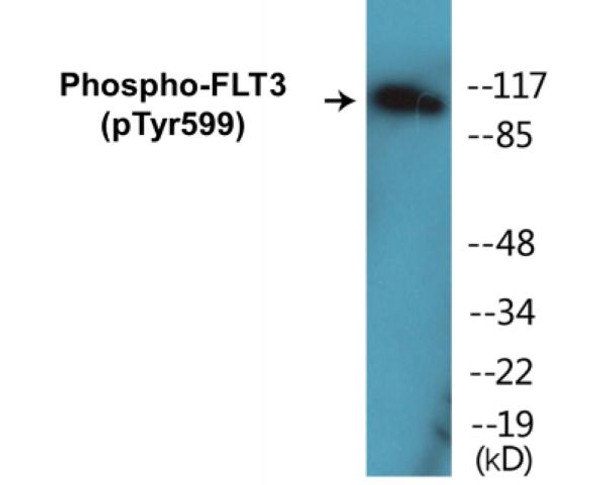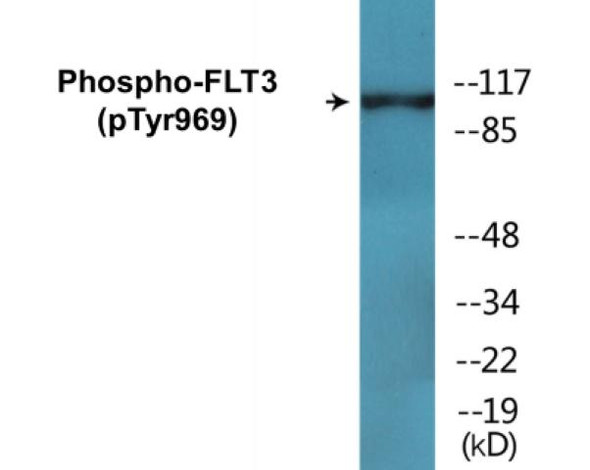Description
FLT3 (Phospho-Tyr599)Colorimetric Cell-Based ELISA Kit
The FLT3 (Phospho-Tyr599) Colorimetric Cell-Based ELISA Kit is specially designed for the accurate and precise detection of FLT3 phosphorylation at tyrosine 599 in cell lysates. This kit offers high sensitivity and specificity, allowing for reliable and reproducible results that are essential for studies in oncology and hematological research.The FLT3 receptor is a key player in regulating cell growth and differentiation, making it a promising target for cancer therapy. Phosphorylation at tyrosine 599 is known to be critical for FLT3 signaling and aberrant activation of this pathway is commonly observed in various hematological malignancies, including acute myeloid leukemia (AML) and acute lymphoblastic leukemia (ALL).
By using the FLT3 (Phospho-Tyr599) Colorimetric Cell-Based ELISA Kit, researchers can gain valuable insights into FLT3 signaling and its role in cancer progression. This kit is essential for studying the molecular mechanisms underlying oncogenesis and identifying potential therapeutic targets for the treatment of FLT3-driven cancers.
| Product Name: | FLT3 (Phospho-Tyr599)Colorimetric Cell-Based ELISA Kit |
| Product Code: | CBCAB01291 |
| ELISA Type: | Cell-Based |
| Target: | FLT3 (Phospho-Tyr599) |
| Reactivity: | Human, Mouse, Rat |
| Dynamic Range: | > 5000 Cells |
| Detection Method: | Colorimetric 450 nm |
| Format: | 2 x 96-Well Microplates |
The FLT3 (Phospho-Tyr599) Colorimetric Cell-Based ELISA Kit is a convenient, lysate-free, high throughput and sensitive assay kit that can detect FLT3 protein phosphorylation and expression profile in cells. The kit can be used for measuring the relative amounts of phosphorylated FLT3 in cultured cells as well as screening for the effects that various treatments, inhibitors (ie. siRNA or chemicals), or activators have on FLT3 phosphorylation.
Qualitative determination of FLT3 (Phospho-Tyr599) concentration is achieved by an indirect ELISA format. In essence, FLT3 (Phospho-Tyr599) is captured by FLT3 (Phospho-Tyr599)-specific primary (1ø) antibodies while the HRP-conjugated secondary (2ø) antibodies bind the Fc region of the 1ø antibody. Through this binding, the HRP enzyme conjugated to the 2ø antibody can catalyze a colorimetric reaction upon substrate addition. Due to the qualitative nature of the Cell-Based ELISA, multiple normalization methods are needed:
| 1. | A monoclonal antibody specific for human GAPDH is included to serve as an internal positive control in normalizing the target absorbance values. |
| 2. | Following the colorimetric measurement of HRP activity via substrate addition, the Crystal Violet whole-cell staining method may be used to determine cell density. After staining, the results can be analysed by normalizing the absorbance values to cell amounts, by which the plating difference can be adjusted. |
| Database Information: | Gene ID: 2322, UniProt ID: P36888, OMIM: 136351, Unigene: Hs.507590 |
| Gene Symbol: | FLT3 |
| Sub Type: | Phospho |
| UniProt Protein Function: | FLT3: a receptor tyrosine kinase of the PDGFR family that binds the FL cytokine. FLT3 -/- mice have an impaired developmental capacity of primitive hematopoietic progenitor cells of all lineages with the greatest impact on lymphopoietic precursors. Activating mutations found in one third of cases of acute myeloid leukemia (AML), as well as in acute lymphoblastic leukemia, acute promyelocytic leukemia and myelodysplastic syndrome. Inhibitors: Sutent and PKC412. |
| UniProt Protein Details: | Protein type:EC 2.7.10.1; Kinase, protein; Membrane protein, integral; Oncoprotein; PDGFR family; Protein kinase, TK; Protein kinase, tyrosine (receptor); TK group Chromosomal Location of Human Ortholog: 13q12.2 Cellular Component: endoplasmic reticulum; integral to plasma membrane; plasma membrane Molecular Function:hematopoietin/interferon-class (D200-domain) cytokine receptor activity; protein binding; protein homodimerization activity; protein self-association; transmembrane receptor protein tyrosine kinase activity; vascular endothelial growth factor receptor activity Biological Process: B cell differentiation; cytokine and chemokine mediated signaling pathway; hemopoiesis; leukocyte homeostasis; lymphocyte proliferation; myeloid progenitor cell differentiation; peptidyl-tyrosine phosphorylation; positive regulation of cell proliferation; positive regulation of MAP kinase activity; positive regulation of MAPKKK cascade; positive regulation of phosphoinositide 3-kinase activity; positive regulation of phosphoinositide 3-kinase cascade; positive regulation of tyrosine phosphorylation of STAT protein; pro-B cell differentiation; protein amino acid autophosphorylation; regulation of apoptosis; transmembrane receptor protein tyrosine kinase signaling pathway Disease: Leukemia, Acute Lymphoblastic |
| NCBI Summary: | This gene encodes a class III receptor tyrosine kinase that regulates hematopoiesis. This receptor is activated by binding of the fms-related tyrosine kinase 3 ligand to the extracellular domain, which induces homodimer formation in the plasma membrane leading to autophosphorylation of the receptor. The activated receptor kinase subsequently phosphorylates and activates multiple cytoplasmic effector molecules in pathways involved in apoptosis, proliferation, and differentiation of hematopoietic cells in bone marrow. Mutations that result in the constitutive activation of this receptor result in acute myeloid leukemia and acute lymphoblastic leukemia. [provided by RefSeq, Jan 2015] |
| UniProt Code: | P36888 |
| NCBI GenInfo Identifier: | 156630887 |
| NCBI Gene ID: | 2322 |
| NCBI Accession: | P36888.2 |
| UniProt Secondary Accession: | P36888,Q13414, A0AVG9, B7ZLT7, B7ZLT8, F5H0A0, |
| UniProt Related Accession: | P36888 |
| Molecular Weight: | 113kDa |
| NCBI Full Name: | Receptor-type tyrosine-protein kinase FLT3 |
| NCBI Synonym Full Names: | fms related tyrosine kinase 3 |
| NCBI Official Symbol: | FLT3 |
| NCBI Official Synonym Symbols: | FLK2; STK1; CD135; FLK-2 |
| NCBI Protein Information: | receptor-type tyrosine-protein kinase FLT3 |
| UniProt Protein Name: | Receptor-type tyrosine-protein kinase FLT3 |
| UniProt Synonym Protein Names: | FL cytokine receptor; Fetal liver kinase-2; FLK-2; Fms-like tyrosine kinase 3; FLT-3; Stem cell tyrosine kinase 1; STK-1; CD_antigen: CD135 |
| Protein Family: | Flt3 receptor-interacting lectin |
| UniProt Gene Name: | FLT3 |
| Component | Quantity |
| 96-Well Cell Culture Clear-Bottom Microplate | 2 plates |
| 10X TBS | 24 mL |
| Quenching Buffer | 24 mL |
| Blocking Buffer | 50 mL |
| 15X Wash Buffer | 50 mL |
| Primary Antibody Diluent | 12 mL |
| 100x Anti-Phospho Target Antibody | 60 µL |
| 100x Anti-Target Antibody | 60 µL |
| Anti-GAPDH Antibody | 60 µL |
| HRP-Conjugated Anti-Rabbit IgG Antibody | 12 mL |
| HRP-Conjugated Anti-Mouse IgG Antibody | 12 mL |
| SDS Solution | 12 mL |
| Stop Solution | 24 mL |
| Ready-to-Use Substrate | 12 mL |
| Crystal Violet Solution | 12 mL |
| Adhesive Plate Seals | 2 seals |
The following materials and/or equipment are NOT provided in this kit but are necessary to successfully conduct the experiment:
- Microplate reader able to measure absorbance at 450 nm and/or 595 nm for Crystal Violet Cell Staining (Optional)
- Micropipettes with capability of measuring volumes ranging from 1 µL to 1 ml
- 37% formaldehyde (Sigma Cat# F-8775) or formaldehyde from other sources
- Squirt bottle, manifold dispenser, multichannel pipette reservoir or automated microplate washer
- Graph paper or computer software capable of generating or displaying logarithmic functions
- Absorbent papers or vacuum aspirator
- Test tubes or microfuge tubes capable of storing ≥1 ml
- Poly-L-Lysine (Sigma Cat# P4832 for suspension cells)
- Orbital shaker (optional)
- Deionized or sterile water
*Note: Protocols are specific to each batch/lot. For the correct instructions please follow the protocol included in your kit.
| Step | Procedure |
| 1. | Seed 200 µL of 20,000 adherent cells in culture medium in each well of a 96-well plate. The plates included in the kit are sterile and treated for cell culture. For suspension cells and loosely attached cells, coat the plates with 100 µL of 10 µg/ml Poly-L-Lysine (not included) to each well of a 96-well plate for 30 minutes at 37 °C prior to adding cells. |
| 2. | Incubate the cells for overnight at 37 °C, 5% CO2. |
| 3. | Treat the cells as desired. |
| 4. | Remove the cell culture medium and rinse with 200 µL of 1x TBS, twice. |
| 5. | Fix the cells by incubating with 100 µL of Fixing Solution for 20 minutes at room temperature. The 4% formaldehyde is used for adherent cells and 8% formaldehyde is used for suspension cells and loosely attached cells. |
| 6. | Remove the Fixing Solution and wash the plate 3 times with 200 µL 1x Wash Buffer for five minutes each time with gentle shaking on the orbital shaker. The plate can be stored at 4 °C for a week. |
| 7. | Add 100 µL of Quenching Buffer and incubate for 20 minutes at room temperature. |
| 8. | Wash the plate 3 times with 1x Wash Buffer for 5 minutes each time. |
| 9. | Add 200 µL of Blocking Buffer and incubate for 1 hour at room temperature. |
| 10. | Wash 3 times with 200 µL of 1x Wash Buffer for 5 minutes each time. |
| 11. | Add 50 µL of 1x primary antibodies Anti-FLT3 (Phospho-Tyr599) Antibody, Anti-FLT3 Antibody and/or Anti-GAPDH Antibody) to the corresponding wells, cover with Parafilm and incubate for 16 hours (overnight) at 4 °C. If the target expression is known to be high, incubate for 2 hours at room temperature. |
| 12. | Wash 3 times with 200 µL of 1x Wash Buffer for 5 minutes each time. |
| 13. | Add 50 µL of 1x secondary antibodies (HRP-Conjugated AntiRabbit IgG Antibody or HRP-Conjugated Anti-Mouse IgG Antibody) to corresponding wells and incubate for 1.5 hours at room temperature. |
| 14. | Wash 3 times with 200 µL of 1x Wash Buffer for 5 minutes each time. |
| 15. | Add 50 µL of Ready-to-Use Substrate to each well and incubate for 30 minutes at room temperature in the dark. |
| 16. | Add 50 µL of Stop Solution to each well and read OD at 450 nm immediately using the microplate reader. |
(Additional Crystal Violet staining may be performed if desired – details of this may be found in the kit technical manual.)






